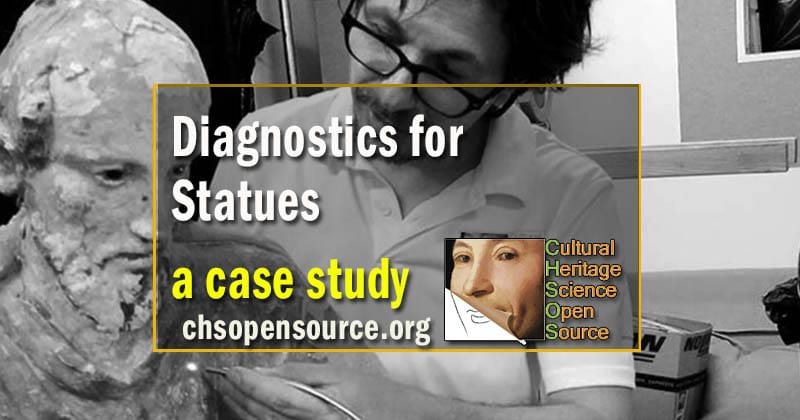
We just performed a diagnostics service for a statue of St. Elijah, in Comiso, Sicily. This is a good opportunity for our art conservation community to review technical photography, spectroscopy, and other tools for the documentation of antique statues, a preparatory examination for the conservation treatment which is undertaken by the Conservation Studio Tiziana Cilia in Comiso.
We thank Parish of Noto, Sicily, for choosing CHSOS for this diagnostic pre-conservation examination.
Technical Photography
We performed a technical photography documentation with 3 methods, VIS, UVF, and IR. It is recommended to first start acquiring visible (VIS) photography at least every 45 degrees, for a total of 8 images. It is also useful to set the acquisition for Polarized light photography (PL). Statues are 3D objects and as in this case often they have gilding which suggests the use of polarized setup. UVF is the other recommended method. It tells a lot about the condition of the paint layer, in this case, it was used to tell the original parts from later retouches. After this preliminary TP documentation, it’s important also to take close up pictures of relevant details.
Reflectance Spectroscopy for telling original gilding from yellow ochre retouches
We used Gorgias, our reflectance spectrometer for Art examination. The statue is extensively gilded but a good part of it is lost. Even in some areas, the bolo (red ochre) preparation is still visible. Gorgias spectrometer clearly identifies it showing the characteristic shape due to iron oxides. We noticed that in some areas losses in the gilding have been replaced with yellow paint that Gorgias identified as yellow ochre.
Reflectance spectroscopy for pigments identification
This statue has few paints: black for the hair and beard, red for lips and pink for the skin tone. The reflectance spectra of the blacks are just flat featureless indicating carbon-based black pigment. The spectrum of skin tones suggests a mixture of lead white and red lead.

Macro photography
Interesting details are revealed and documented with macro photography. The eyes of the statues often bring a lot of information on the workshops that produced them. As in this case, they are made of tinted glass as used in the most precious statues, rather than just painted glass.
Endoscopy
Endoscopy is an essential tool in the examination of wooden and mixed materials statues to get plenty of information on their internal structure.

























